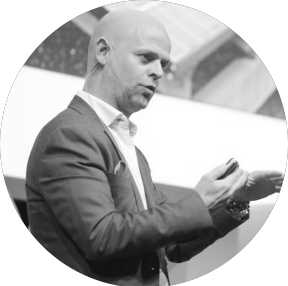Article | by Olly Forrester
The good, the bad and the baffling of data-speak
As the industry waxes lyrical about data, our Data Analyst, Becki Hemming, does a translation job on the sayings we've heard doing the rounds.
Article | by Olly Forrester
![]()
On donning our lanyards at The Hilton, we were soon surrounded by other B2B bods. People who instantly ‘got’ our agency proposition, seemed to know every client in our portfolio, and understood the ‘dry’ products and sectors we bring to life with our ‘bye 2 boring’ campaigns.
This sense of community was to set the tone for two days of hardcore conferencing. From Caterpillar to Schneider, we heard from some big hitters as well as some inspiring brands that were new to us Freestylers – honourable shout-outs to Danfoss and Rockwool.
Here we bring you the subjects that got the most airtime at B2B Online 2017. The topics that repeatedly came up in presentations, and the debates that divided opinion in the cafes – only mucking, we kept it professional.
Hello Amsterdam - up bright and early for the #B2Bonline conference pic.twitter.com/sRoqQBT39x
— FreestyleInteractive (@freestyleint) 28 November 2017
How do you get 20-30 year-olds to shun B2C employers and ply their digital talents in the B2B space? This one came up a lot. As did the question of diversity, with one attendee quipping that the delegates were best described as ‘bloke 2 bloke'.
When Farrukh Shad was quizzed on his biggest challenge in bringing about digital transformation at Schneider, he replied without hesitation: “Recruiting millennials. We didn’t anticipate this.”
Several presenters talked about manufactures facing a coming ‘knowledge gap’. As product experts retire, what happens to the technical knowledge they’ve acquired over decades? Who or what fills their shoes?
And what of new roles in emerging technologies? How do B2B companies attract talent in areas like data engineering and AI?
Grundfos’ Fredrik Östbye shared a useful approach to the recruitment problem. To challenge the perception that the pump manufacturer is ‘boring’, he focuses on the company’s purpose:

We’re a boring pump manufacturer in the middle of nowhere in Denmark. But we have a really strong purpose: sharing water with the world. When we talk about how digital transformation enables this purpose, we get really good talent.
Fredrik Östbye, Grundfos
There’s plenty of research showing that ‘millennials’ (we don’t like the word either) are the ‘purpose-driven’ generation, favouring social impact over salary. While this view might generalise, it’s not without foundation.
Talking about purpose and highlighting their life-enhancing applications gives B2B employers a great way to engage with young talent and counter the allure of B2C.
 Inevitably, the differences and similarities between B2B and B2C worlds were a consistent talking point across panels and roundtables. We even had an ambitious ‘B2G’ acronym at one point – ‘business to government’, anyone?
Inevitably, the differences and similarities between B2B and B2C worlds were a consistent talking point across panels and roundtables. We even had an ambitious ‘B2G’ acronym at one point – ‘business to government’, anyone?
But Rockwool’s Alessandro Bracco did a good job of cutting through the noise with his simple observation: “Isn’t a B2B customer just a B2C person who goes to work?”
Dow’s Carlos Silva Lopes took the sentiment even further: “In essence, B2B is P2P; person to person”. It’s a drum we’ve been banging at Freestyle for some time. Our most successful campaigns are always those that wrap a B2B product in a human story.
The conference consensus was that the lines between B2B and B2C are blurring. The expectations of B2B customers when it comes to e-commerce have increased profoundly, driven by the ‘frictionless’ apps of B2C disruptors.
As Grainger’s Shailesh Sood put it: “As consumers we’ve experienced what good looks like in the B2C world. We’ve experienced how Amazon anticipates our needs, how AirBnB give us a seamless experience, how Uber puts us in control.”
The result: people increasingly expect the same experiences from their B2B transactions. And therein lies the opportunity for digitally-savvy B2B brands. By focusing on the online experience as a means of differentiation, manufacturers and distributors can stand apart from competitors.
Shailesh summed it up nicely:
Shailesh Sood, Grainger

Which brings us onto emerging technologies and their role in enhancing customer experience. Many presentations touched on the theoretical applications of AI and machine learning in e-commerce. But more interesting were the practical examples of where these technologies have been introduced in the B2B space.
Manutan, distributor of office and warehouse supplies, shared a case study on how they developed their AR app. Inspired by Ikea Place, the augmented reality application allows users to visualise products such as shelving and racking in their production environment, without having to measure dimensions.
We also heard from Caterpillar’s Holger Pietzsch about how the construction manufacturer is using IoT for predictive maintenance of their machinery, saving customers huge sums by eliminating downtime and excess capacity.

Digital transformation is still the buzz phrase of the moment. In Amsterdam we heard a lot about the quest for DT and the agile culture needed to enable it.
"To realise digital transformation you have to work agile. You have to be prepared to fail. If you’re not failing, you’re not working hard enough" argued Herbert Pesch, CCO of Evident.
This ‘rapid test and learn’ mantra was repeated across the two days and embraced by most speakers as the driver of innovation. But interestingly, the best DT case studies came from businesses that have created separate digital transformation units or ‘labs’, distanced from traditional business functions.
Danfoss’s Thomas Kolster gave a frank and fascinating account of their DT unit, ‘The Ramp’, which is making headway at an arm’s length from the business (‘the mothership’).
Justifying the creation of this innovation centre, Thomas argued:

Digital marketing departments are holding back digitalisation. The dilemma of marketing is that it tries to take responsibility for the end-to-end customer journey – but it has no mandate to do this.
Thomas Kolster, Danfoss
The Ramp, with members drawn from across the Danfoss mothership and beyond, has such a mandate. Thomas’s team is tasked with exploring and building digital products which enhance the full CX journey. “The magic happens when we apply The Ramp’s knowledge of digital to the mothership’s knowledge of our customers”, he explained. "We don’t just chase the tech and fall for ‘shiny object syndrome.”

Finally, an observation that has nothing to do with digital and everything to do with people.
I’m not normally one for conference small talk. ‘Networking breaks’ can feel a bit forced. Trying to sneak a glance at people’s name tags as you reel off your client base can get a bit tiresome, especially when the person you’re networking with hasn’t got the foggiest idea who you’re talking about. Or perhaps that’s just the blue in me – great presentation, Doug Spence.
But at B2B Online it never felt awkward. We were all on the same page.
An example:
Turns out she was marketing manager for a workplace safety supplier. We were united by niche knowledge. And a shared appreciation that ‘maintenance, repair and overhaul’ is only as dull as you make it.
After talking with another delegate about e-commerce challenges for industrial distributors, we found common ground in a shared love of little-known British punk band, Sleaford Mods. A camaraderie was born.
So, for two days it felt like a community. A community founded on complex products and conservative industries, perhaps, but also ambitious marketers who are passionate advocates of digital. And nice people too.
Here’s to B2B Online 2018.
And that’s a wrap! Thanks so much for joining us in Amsterdam. We can’t wait to see you again next year! #b2bonline pic.twitter.com/kYTuZ0v9Va
— B2B Online Europe (@B2BOnlineEu) 29 November 2017